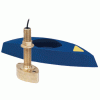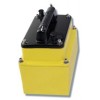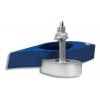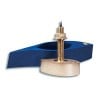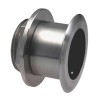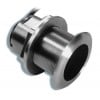
How Does a Depth Transducer Work?
The easiest way to understand how a transducer functions is to think of it as a speaker and a microphone built into one unit. A transducer receives sequences of high-voltage electrical pulses called transmit pulses from the echosounder. Just like the stereo speakers at home, the transducer then converts the transmit pulses into sound. The sound travels through the water as pressure waves. When a wave strikes an object like a weed, a rock, a fish, or the bottom, the wave is reflected. The wave is said to echo—just as your voice will echo off a canyon wall. When the reflected sound wave returns the transducer acts as a microphone. It receives the sound wave during the time between each transmit pulse and converts it back into electrical energy.
A transducer will spend about 1% of its time transmitting and 99% of its time quietly listening for echoes. Remember, however, that these periods of time are measured in microseconds, so the time between pulses is very short. The echosounder can calculate the time difference between a transmit pulse and the return echo and then display this information on the screen in a way that can be easily understood by the user.




